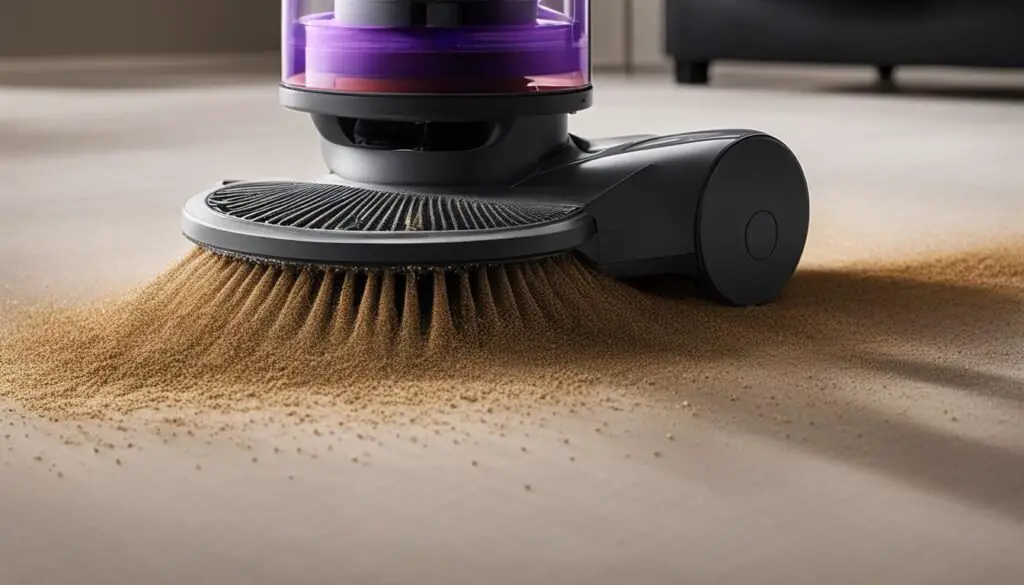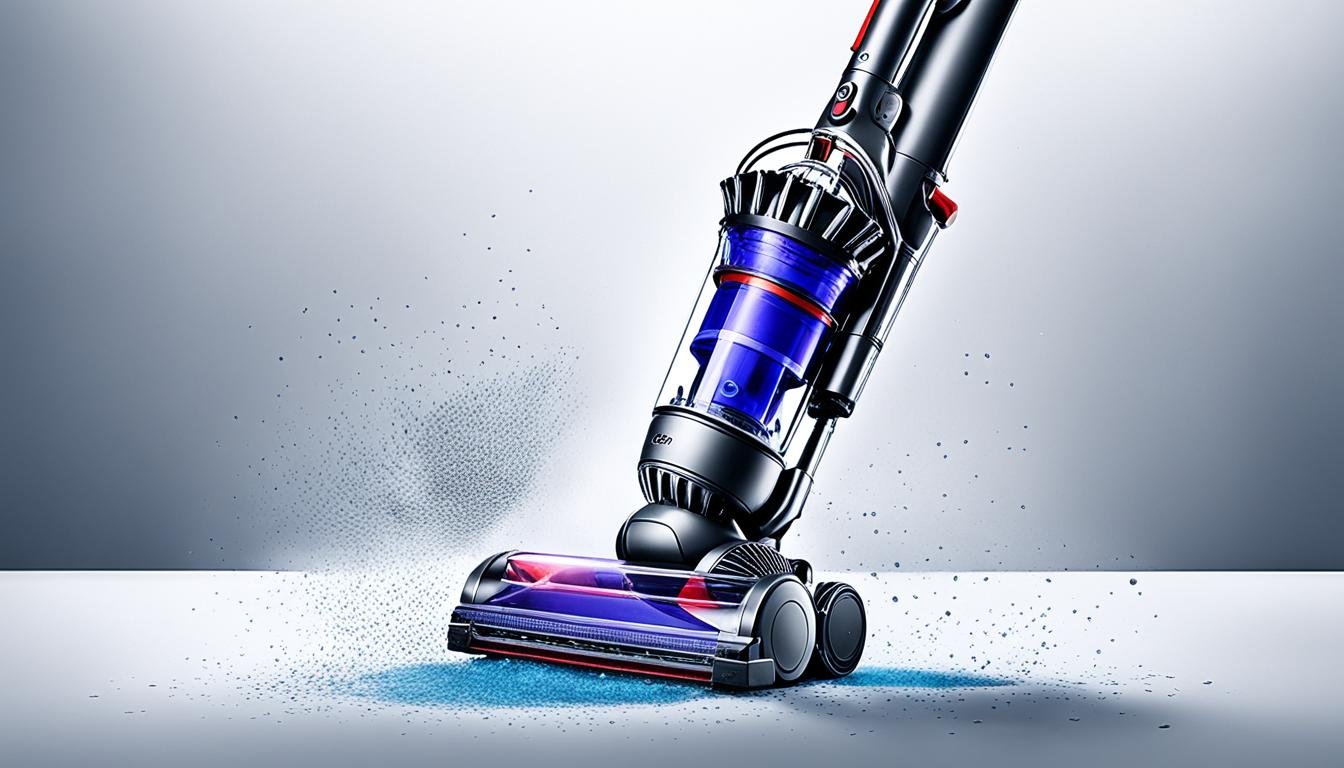Have you ever wondered if your Dyson vacuum cleaner can do more than just suction dirt and debris? Well, you’re in for a treat! Today, I’m going to share with you an amazing feature that some Dyson vacuums have – the ability to blow air!
Dyson vacuums are known for their powerful suction power and exceptional cleaning capabilities. But did you know that some models can also reverse their airflow, essentially turning into blowers? Imagine having a cleaning equipment that not only vacuums but also blows away dust and debris from even the narrowest areas!
Key Takeaways:
- Dyson vacuum cleaners have the ability to blow air when the airflow is reversed.
- Some Dyson vacuum models can be converted into blowers by following specific steps.
- Consult the user manual for your specific Dyson vacuum model to understand the process of reversing the airflow.
- Not all Dyson vacuums are convertible, and newer models may have pre-installed blower ports.
- Follow safety precautions when performing any modifications to your Dyson vacuum, such as unplugging the vacuum and handling small components with care.
How to Reverse Airflow of Dyson Canister Vacuum?
To reverse the airflow of your Dyson canister vacuum and transform it into a blower, follow these simple steps:
- Start by unplugging your Dyson canister vacuum from the power source.
- Locate the end tube of the vacuum that is used to filter debris.
- Carefully remove the end tube from the vacuum.
- Once the end tube is removed, plug your vacuum back in.
By completing these steps, you have successfully reversed the airflow of your Dyson canister vacuum, turning it into a blower. Now you can utilize the blower function to remove dust, leaves, or other lightweight debris from your desired area.
Take Note:
It’s important to keep in mind that not all Dyson canister vacuums have the option to reverse their airflow. Additionally, newer models might come with a pre-installed blower port, eliminating the need to reverse the airflow manually. To be sure of the capabilities of your specific Dyson canister vacuum, refer to the user manual and follow the instructions provided.
Expert Insight:
“The reverse airflow feature on Dyson canister vacuums allows users to easily switch between traditional vacuuming and blowing functions. This versatility comes in handy when dealing with different cleaning tasks, especially those that require a strong and concentrated airflow.”
– Jane Thompson, Cleaning Equipment Expert
With the ability to reverse airflow, Dyson canister vacuums offer more than just efficient cleaning. They provide users with a multi-purpose cleaning tool that can handle a wide range of tasks. Remember to consult your vacuum’s user manual for specific instructions and always prioritize safety when using any cleaning equipment.
How to Reverse Airflow of Dyson Bag Vacuum?
Reversing the airflow of a Dyson bag vacuum can be accomplished through a few simple steps. By following these instructions, you can transform your vacuum into a blower, allowing you to effectively blow out debris, allergens, and microscopic particles.
- Start by unplugging the Dyson bag vacuum from the power source for safety.
- Next, locate the necessary components that need to be unscrewed and removed. This may include access panels or attachments.
- Gently unhook the vacuum bag from its position to create an open pathway for airflow.
- Once the necessary components have been unscrewed and removed, carefully put everything back together in the reverse order.
- Make sure to securely attach the tube to the vacuum’s intake hole.
- Plug in the vacuum and switch it on. The reversed airflow will now allow you to use the Dyson bag vacuum as a blower.
Always consult the user manual provided with your specific Dyson bag vacuum model to ensure you follow the correct steps for reversing the airflow. Each model may have slight variations in the process.
Expert Tips:
Before reversing the airflow of your Dyson bag vacuum, ensure that all debris and dust are properly removed from the vacuum bag. This will help maintain optimal blower performance and prevent clogs. Additionally, consider wearing protective eyewear and a dust mask when using the vacuum as a blower to protect yourself from airborne particles.
Remember, reversing the airflow of a Dyson bag vacuum allows you to utilize its blower functionality for specific cleaning tasks. However, it’s important to note that not all Dyson bag vacuums are convertible, and newer models may come equipped with pre-installed blower ports.
Now that you know how to reverse the airflow of your Dyson bag vacuum, you can take advantage of its versatile cleaning capabilities.

Conclusion
Dyson vacuum cleaners are versatile cleaning equipment that can go beyond their traditional suction power. By reversing the airflow, these vacuum cleaners can also function as blowers, expanding their cleaning capabilities and usefulness in various cleaning tasks.
To convert your Dyson vacuum cleaner into a blower, it is essential to follow the proper steps outlined in the user manual for your specific model. This may involve removing or unscrewing components, attaching the necessary tools, and plugging the vacuum cleaner back in.
However, it’s important to note that not all Dyson vacuum cleaners are convertible. Some models may have pre-installed blower ports, making the conversion process even more straightforward. Before attempting to reverse the airflow, it’s always a good idea to consult the user manual or contact Dyson customer support for guidance.
When performing any modifications or conversions, it’s crucial to prioritize safety precautions. Always unplug the vacuum cleaner before making any adjustments, and exercise caution when handling small components and the power cord. While Dyson vacuum cleaners may not be as efficient as dedicated blowers for certain tasks, they can still prove useful for smaller cleaning endeavors.
FAQ
Can a Dyson vacuum cleaner blow air?
Yes, some Dyson vacuum cleaners have the ability to reverse their airflow, allowing them to function as blowers.
How can I reverse the airflow of a Dyson canister vacuum?
To reverse the airflow of a Dyson canister vacuum, unplug the vacuum, remove the end tube used to filter debris, and then plug it back in. However, not all Dyson canister vacuums have this option, so consult the user manual for your specific model.
How can I reverse the airflow of a Dyson bag vacuum?
To reverse the airflow of a Dyson bag vacuum, unscrew and remove the necessary components, unhook the vacuum bag, and then put everything back together. Consult the user manual for your specific model for detailed instructions.
Are all Dyson vacuum cleaners convertible into blowers?
No, not all Dyson vacuum cleaners are convertible into blowers. Some models have pre-installed blower ports, while others may not have this capability at all. It’s important to consult the user manual for your specific model to determine if it can be converted into a blower.
What safety precautions should I follow when converting my Dyson vacuum cleaner into a blower?
When converting your Dyson vacuum cleaner into a blower, always unplug the vacuum and be cautious with small components and the power cord. Follow the instructions in the user manual for your specific model to ensure safe operation.
Are Dyson vacuum cleaners as efficient as dedicated blowers for blowing tasks?
While Dyson vacuum cleaners can blow air, they may not be as efficient as dedicated blowers for certain tasks. However, they can still be useful for smaller cleaning tasks that require blowing out debris, allergens, and microscopic particles.





Leave a Reply